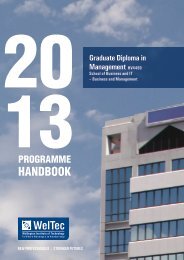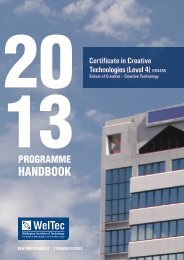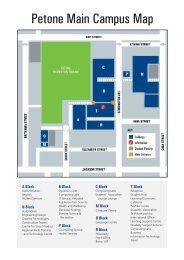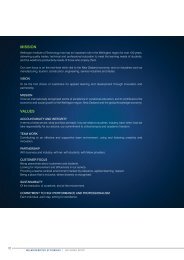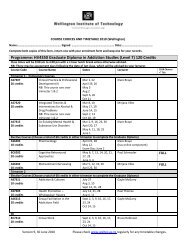Download PDF (7.6MB) - Wellington Institute of Technology
Download PDF (7.6MB) - Wellington Institute of Technology
Download PDF (7.6MB) - Wellington Institute of Technology
Create successful ePaper yourself
Turn your PDF publications into a flip-book with our unique Google optimized e-Paper software.
Notes to the Financial Statements<strong>of</strong> the transaction. Exchange rate differences are recognised in thestatement <strong>of</strong> comprehensive income in the period in which they arise.Goods and Services TaxAll items in the financial statements are stated exclusive <strong>of</strong> goods andservices tax (GST), except for trade and other receivables and tradeand other payables, which are presented on a GST-inclusive basis.Where GST is not recoverable as input tax then it is recognised as part<strong>of</strong> the related asset or expense.The net amount <strong>of</strong> GST recoverable from, or payable to InlandRevenue is included as part <strong>of</strong> receivables or payables in the balancesheet.The net GST paid to, or received from Inland Revenue, including theGST relating to investing and financing activities, is classified as a netoperating cash flow in the statement <strong>of</strong> cash flows.Commitments and contingencies are disclosed exclusive <strong>of</strong> GST.Impairment <strong>of</strong> AssetsAt each balance date, WelTec and Group assesses whether thereis any objective evidence that a financial asset or group <strong>of</strong> financialassets is impaired. Any impairment losses are recognised in the pr<strong>of</strong>itor loss.Loans and receivablesImpairment <strong>of</strong> a loan or a receivable is established when there isobjective evidence that WelTec and Group will not be able to collectamounts due. Significant financial difficulties <strong>of</strong> the debtor, probabilitythat the debtor will enter into liquidation or default on payments areconsidered indicators that the asset is impaired.For debtors and other receivables the carrying amount <strong>of</strong> the asset isreduced through the use <strong>of</strong> an allowance account, and the amount<strong>of</strong> the loss is recognised in the pr<strong>of</strong>it or loss. When the receivable isuncollectable, it is written <strong>of</strong>f against the allowance account. Overduereceivables that have been renegotiated are reclassified as current(that is, not past due).Other Financial Assets, Property, Plant and EquipmentIf any indication <strong>of</strong> impairment exists, the recoverable amount <strong>of</strong> theasset is estimated in order to determine the extent <strong>of</strong> the impairmentloss (if any). Where the asset does not generate cash flows that areindependent from other assets, the recoverable amount from thecash-generating unit to which the asset belongs is estimated.Recoverable amount is the higher <strong>of</strong> fair value less costs to sell andvalue in use. In assessing value in use, the estimated future cashflows are discounted to their present value, using a discount rate thatreflects current market assessments <strong>of</strong> the time value <strong>of</strong> money.If an asset’s carrying amount exceeds its recoverable amount, the assetis impaired and the carrying amount is written-down to the recoverableamount. For revalued assets the impairment loss is recognised inother comprehensive income to the extent the impairment loss doesnot exceed the amount in the appropriate revaluation reserve. Wherethat results in a debit balance in the revaluation reserve, the balance isrecognised in the pr<strong>of</strong>it or loss.For assets not carried at a revalued amount, the total impairment lossis recognised in the pr<strong>of</strong>it or loss.The reversal <strong>of</strong> an impairment loss on a revalued asset is credited toother comprehensive income and increases the applicable revaluationreserve, unless an impairment loss was previously recognised in thepr<strong>of</strong>it or loss, in which case the reversal <strong>of</strong> the impairment loss is alsorecognised in the pr<strong>of</strong>it or loss.For assets not carried at revalued amount the reversal <strong>of</strong> an impairmentloss is recognised in the pr<strong>of</strong>it or loss.Intangible AssetsIntellectual property costsDevelopment costs for new intellectual property internally developedor acquired which have a benefit <strong>of</strong> more than 1 year have beencapitalised. Such costs are expected to be recovered, and areamortised on a straight-line basis over the period <strong>of</strong> their expecteduseful lives, being 3 years.S<strong>of</strong>twareAll s<strong>of</strong>tware purchased or created by WelTec and Group which havea benefit <strong>of</strong> more than 1 year have been capitalised. Such costs areexpected to be recovered, and are amortised on a straight-line basisover the period <strong>of</strong> their expected useful lives, being 3 years.Assets under constructionCourse development and s<strong>of</strong>tware assets under construction aretreated as an intangible asset until completion. Upon completion <strong>of</strong> aproject, the total cost is transferred to the appropriate asset class, atwhich point amortisation begins.InventoriesInventories available for resale are valued at the lower <strong>of</strong> cost and netrealisable value. Consumables are recorded at cost.InvestmentsInvestments are initially recognised at cost, being the fair value <strong>of</strong> theconsideration given. After the initial recognition, investments which areclassified as available-for-sale are measured at fair value. Investmentsthat are intended to be held-to-maturity are subsequently measuredat amortised cost using the effective interest method. Amortisedcost is calculated by taking into account any discount or premiumon acquisition, over the period to maturity. Any changes in fair valuethroughout the term <strong>of</strong> the investment are recognised within thestatement <strong>of</strong> comprehensive income.Leased AssetsOperating lease payments, where the lessor effectively retainssubstantially all the risks and rewards <strong>of</strong> ownership <strong>of</strong> the leaseditems, are recognised as an expense on a straight-line basis over thelease term.PayablesTrade payables and other accounts payable are recognised whenWelTec and Group becomes obliged to make future paymentsresulting from the purchase <strong>of</strong> goods and services.Other Financial AssetsFinancial assets are initially recognised at fair value. Financial assetsare derecognised when the rights to receive cash flows from thefinancial assets have expired or have been transferred and WelTecand the Group has transferred substantially all the risks and rewards<strong>of</strong> ownership.Financial assets are classified into the following categories for thepurposes <strong>of</strong> measurement:• Loans and receivablesLoans and receivables are non-derivative financial assets with fixedor determinable payments that are not quoted in an active market.Related party receivables that are repayable on demand are classifiedas a non-current asset because repayment <strong>of</strong> the receivable is notexpected within 12 months <strong>of</strong> balance date.64 | WELLINGTON INSTITUTE OF TECHNOLOGY



